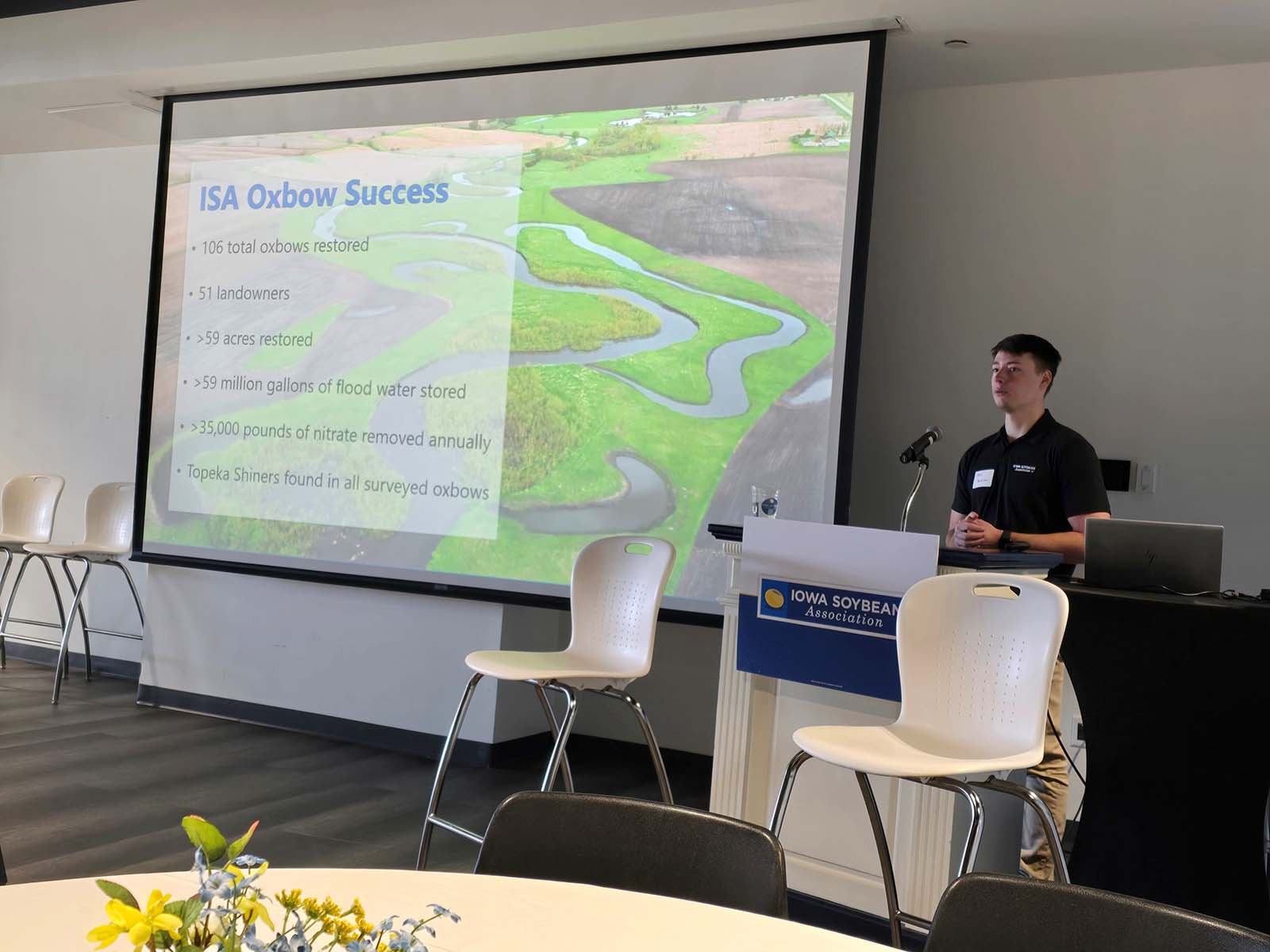
(Photo credit: Jeff Hutton/Iowa Soybean Association)
Innovation to Profit highlights various issues
March 13, 2025
By Jeff Hutton
Oxbow restoration, cover crops, concerns over the uncertainty of what’s happening at the federal level – just some of the discussion that occurred during the recent Iowa Soybean Association’s (ISA) Innovation to Profit event held in Storm Lake.
A good-sized crowd attended the event at Buena Vista University where ISA staff shared with farmers their insights and perspectives into what’s happening out in the fields.
Uncertainty in D.C.
Tariffs, trade woes and a freeze on federal programs are top of mind for many farmers, says Mike Gilman, the conservation agronomy lead with ISA.
“It’s a bit troubling at this juncture,” he says.
But that doesn’t change the fact that ISA and its outreach to farmers across the state will continue.
“ISA is a nationally recognized leader in farm conservation,” Gilman says. “Our farmer-led research is here to help farmers and improve their operations – improve productivity, profitability and sustainability.”
And despite the uncertainty in Washington, D.C., ISA’s Research Center for Farming Innovation (RCFI) and its team is committed to stand with farmers, Gilman says.
“We want to continue to be a resource to you, provide data and keep you informed as to what’s going on federally,” he says. “We’re here to help elevate your voice as the state and federal level. We work for and support the Iowa soybean farmer.”
Oxbow successes
Alex Buseman, a conservation services manager for ISA, touted the benefits of a number of practices farmers have engaged in or may want to in the future.
That includes edge-of-field practices that are designed to operate with minimal human input.
“We don’t want to change your operation or take acres out of service,” Buseman says.
Benefits include water quality, flood mitigation and improving wildlife habitat (like the re-emergence of the Topeka shiner).
Oxbows, saturated buffers and woodchip bioreactors are examples of these types of practices that farmers can implement.
Buseman says over the past few years, ISA has helped to restore 106 oxbows in Iowa, roughly 59 acres total.
That is turn, he says, has meant 59 million gallons of flood water restored and 35,000 lbs. of nitrates removed annually.
“These oxbows are working,” Buseman says.
He added that ISA is leaning into this type of practice, helping farmers with funding sources, working as a middle man with contractors, construction oversight and more.
Buseman says he and ISA Senior Conservation Manager Brandon Iddings, as well as Water Lab Service Manager Tony Seeman are committed to surveying opportunities that will work for individual farm operations. He says Seeman can test for water quality, nitrate levels, while also monitoring existing practices.
“We’re confident we can deliver high-quality performance for you,” Buseman says.
Cover crop options
ISA Conservation Agronomist Ryan Johnson posed two questions to the audience during the presentation.
“Cover crops – which route sets me up for success? What is your goal with cover crops?” he asked.
Johnson says different farmers and different fields will elicit varied reasons.
Is it feed for livestock, weed suppression, nutrient uptake/nutrient holding, erosion control, soil health, water quality?
Farmers, Johnson says, need to look at species selection – will grasses like oats and cereal rye provide the best results? Or maybe it’s legumes like hairy vetch or red clover? Perhaps brassicas like radish, rapeseed/canola or winter camelina will work best.
Johnson then highlighted seeding methods including aerial seeding, drill seeding and high clearance seeding, which vary when it comes to timeframe and seed-to-soil contact.
ISA, he says, can help farmers, decide what the details are and hopefully what will work for a specific field.
There are also termination concerns:
Winter kill (hard winter freeze) means choose a species that will consistently kill – summer annuals like oats or radish are generally ideal in this situation.
There’s chemical termination – integrating termination pass into one’s herbicide program to target both cover crops and early season weeds in the same pass.
And what about mechanical termination?
Johnson says farmers who plant to mechanically terminate their cover crops in the spring might consider roller crimping as an option. An ideal scenario is roller crimping a plant with the growing point well above the soil surface, like cereal rye at anthesis (flowering) or later.
Johnson noted that cover crop tours is a way that ISA can help farmers decide what might work best for them, allowing the interested to survey what others do, and whether or not it’s successful.
He highlighted a number of cost-share opportunities through public funding like Farmers for Soil Health, Iowa Department of Agriculture and Land Stewardship’s (IDALS) Water Quality Initiative, the Natural Resources Conservation Service’s (NRCS) Environmental Quality Incentives Program (EQIP) and NRCS Conservation Stewardship Program (CSP).
Private funding from Practical Farmers or Iowa or Truterra is also an option, as is public and private funding from the Soil & Water Outcomes Fund (SWOF) and the Regional Conservation Partnership Program (RCPP).
‘Never stop learning’
Doug Gronau, who farms just east of Denison near the town of Vail, has been in the fields for more than 50 years, primarily focused on soybeans and corn.
He says the Innovation to Profit event and similar programs appeal to him because he likes hearing about new opportunities and developments in research.
“I’m pretty active in conservation with terraces, no-till, cover crops and water ways,” Gronau says. “But you can never stop learning. We’ve picked up a lot of things over the years and it’s working for us.”
Back